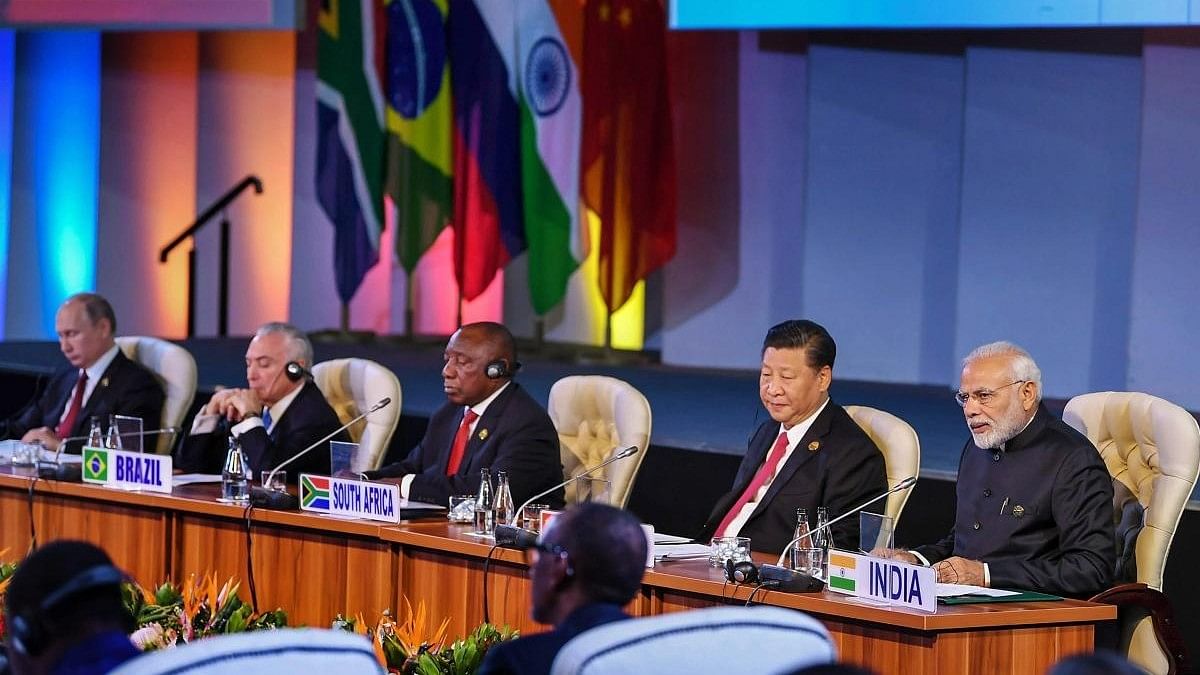
Prime Minister Narendra Modi addresses at the BRICS Africa Outreach and BRICS Plus Outreach, in Johannesburg, South Africa.
PIB Photo via PTI
India can join Russia, China, Brazil and South Africa in a space exploration consortium, Prime Minister Narendra Modi proposed on Wednesday, just a few hours before the ISRO’s Chandrayaan-3 successfully landed on the moon.
The excitement over India’s moon mission reached Johannesburg in South Africa where the prime minister was attending the first plenary of the 15th summit of the BRICS. “In a few hours, India's spacecraft Chandrayaan-3 will be landing on the moon. We congratulate you (Modi),” South African president, Cyril Ramaphosa, the host of the summit, said after the prime minister delivered his speech at the conclave.
“This, for us as the BRICS family, is a momentous occasion and we rejoice with you. We join you in the joy of this great achievement," Ramaphosa told Modi amid applause from the other leaders of the bloc.
Modi earlier proposed a BRICS Space Exploration Consortium. “Under this, we can work for global good in areas like space research, and weather monitoring,” he told the other BRICS leaders.
He noted that the five nations were already working on the BRICS satellite constellation and said that the bloc could make a step forward and consider creating the space exploration consortium.
India in August 2021 clinched a deal with China, Russia, Brazil and South Africa to set up a BRICS constellation of remote sensing satellites launched and operated by the space agencies of the five nations to share data among themselves for management of disasters and natural resources. The agreement enabled the creation of a network of remote sensing satellites and ground stations launched and operated by the space agencies of the BRICS nations.
The satellites participating in the BRICS constellations include China-Brazil Earth Resources Satellite-4 (CBERS-4) system, Kanopus-V Earth observation satellites of Russia, ResourceSat-2 Remote Sensing satellite of India. China’s GaoFen-1 (GF-1) series of earth observation satellites is also participating in the network. The participating ground stations include Cuiaba in Brazil, Shadnagar–Hyderabad in India, Sany in China, Hartebeesthoek in South Africa and Moscow in Russia.
The prime minister also proposed stepping up cooperation among the BRICS nations in education, skill development and technology. “To make BRICS a future-ready organization, we have to make our societies future-ready. Technology will play an important role in this,” he said, citing the example of the DIKSHA (Digital Infrastructure for Knowledge Sharing) platform of India to provide education to the children of remote and rural areas. He also cited the 10,000 Atal Tinkering Labs created across the country promoting innovation among school students.
“Bhashini, an AI-based language platform, is being used in India to remove language barriers. The CoWIN platform has been created for vaccination. Public service delivery is being revolutionized through Digital Public Infrastructure or India Stack,” said the prime minister.
He added that diversity was a great strength of India and the solution to any problem in India comes out at the test of this diversity. “That's why these solutions can be easily implemented in any corner of the world.”
He said that India would be happy to share all these platforms developed in India with other BRICS nations.
The prime minister suggested that the BRICS nations could do skills mapping together to identify each other's strengths. Noting that a large number of big cats of different species were found in all the five countries of BRICS, he said that the bloc could make joint efforts for their protection under the “International Big Cat Alliance”.
Modi also suggested that the BRICS nations could create a repository of traditional medicines.
